From leading employers to nightlife hotspots, Life in Indy is your comprehensive guide to the Indianapolis region. This site gives you a full virtual tour experience, so you can explore our community and decide where in Indy is the best place for your new home.
The Indianapolis Motor Speedway is the Racing Capital of the World.
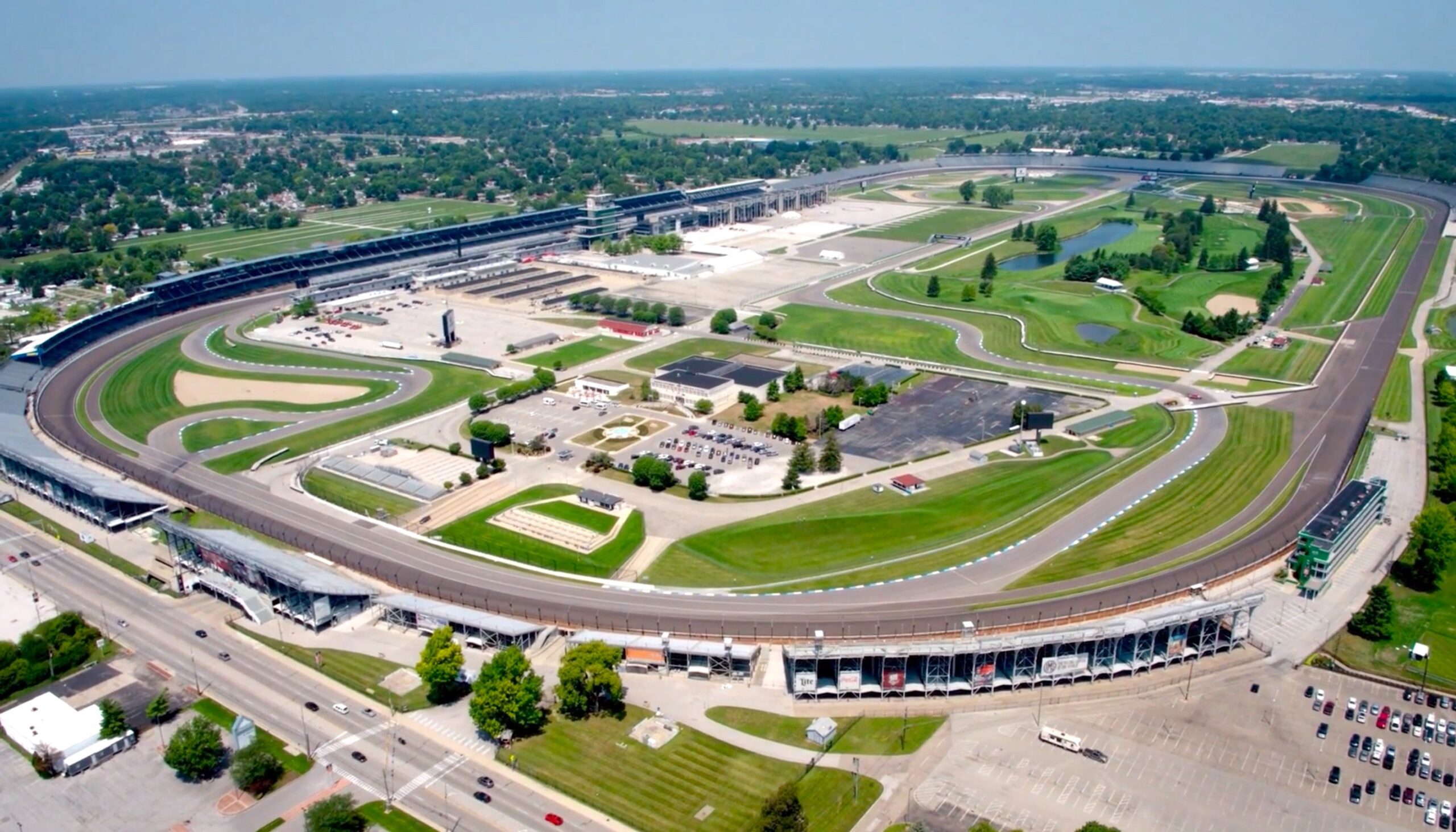
Photo courtesy of Indianapolis Motor Speedway
For over a century, the Indianapolis Motor Speedway has been a beloved Hoosier icon and the undisputed Racing Capital of the World. This legendary race track lies in the heart of Speedway, Indiana—just six miles from the heart of Indianapolis—where you’ll find a hub of automotive history and innovation.
The Indianapolis Motor Speedway is famous for hosting high-speed events and racing legends across the globe, including some of the biggest names in motorsports. NASCAR, IndyCar, and even Formula 1 Grand Prix have all graced this storied track. And with over 250,000 seats for ecstatic fans to fill, IMS remains the largest sports venue in the world!
Every May, race fans from all over the world flock to IMS to witness the Greatest Spectacle in Racing—the Indianapolis 500. This 200-lap race typically attracts over 300,000 spectators, who pack the stands and still find room for lawn chairs in the infield.
The Indy 500 is easily the biggest event held at the Indianapolis Motor Speedway. But there are plenty of other important races to attend throughout the year, such as the annual Brickyard 400, the Pennzoil 250, and the IMSA Battle on the Bricks. Visiting IMS also gives you a chance to experience racing history firsthand, as you tour the track and kiss the bricks where it all began.
The Indianapolis Motor Speedway is home to centuries of motorsport history.
The automotive industry in Indiana skyrocketed during the early 20th century, making Indianapolis the nation’s 4th highest producer of automobiles. But the city’s manufacturers needed a place to test their new technology.
Local entrepreneur Carl G. Fisher saw this need, alongside a growing interest in automobile racing, and he began to envision the blueprints for the greatest race course in the world. Fisher gathered a few other businessmen, and the group invested $250,000 into building a state-of-the-art testing facility for Hoosier automotives. They also agreed this new track should host motorcar races which would provide an exciting opportunity to entertain audiences while tactfully marketing the manufacturer’s products.
The first draft of this new “motor parkway” consisted of a 5-mile oval circuit. In order to maximize space for spectators, the venue’s design went through rounds of modifications, including revisions from New York civil engineer, P.T. Andrews. What remained was the iconic 2.5-mile track that is still the pride and joy of Indianapolis today.
The Indianapolis Motor Speedway officially opened in 1909 to great acclaim, but testing proved that the track would need sturdier pavement to ensure drivers’ safety. In 1911, they replaced the track with a layer of 3.2 million bricks that would earn the speedway its famous nickname: “The Brickyard.”
Another notable piece of IMS history was the construction of its iconic Pagoda in 1913. This 9-tier building stretches 153 feet into the sky and stands adjacent to the starting line of the track, where it serves as the center for race control, safety, and broadcasting. Although the building has been reconstructed a few times, the Pagoda at IMS today still maintains the distinct Japanese architecture that gave the structure its name.
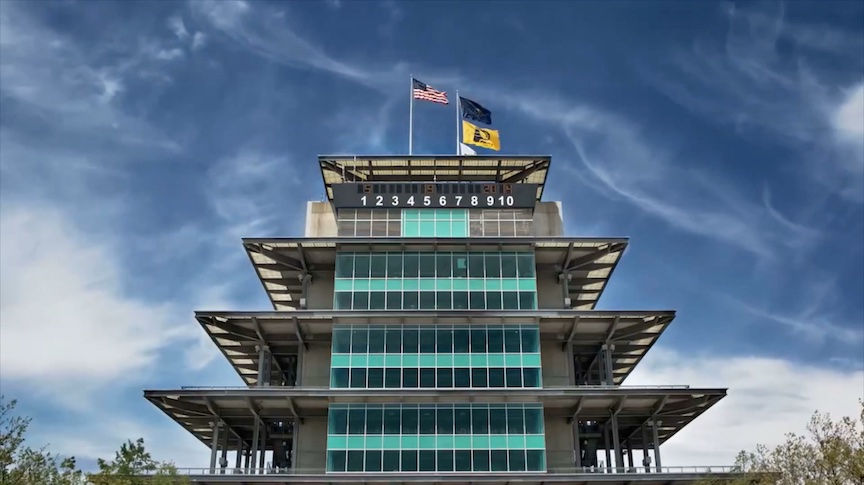
Photo courtesy of Visit Indy
The Greatest Spectacle in Racing brings thousands to Indy every year.
You simply cannot tell the story of the Indianapolis Motor Speedway without mentioning the track’s most famous race—The Indianapolis 500. This Memorial Day Weekend tradition is the largest single-day sporting event in the world and is known as the Greatest Spectacle in Racing.
Since the race began in 1911, the Indy 500 has blazed a trail for the motorsports industry. Back then, it was one of the longest auto races in the world, which led to rapid advancements in automobile endurance. The rear-view mirror was invented at the Indy 500, after Ray Harroun won the inaugural race by using this revolutionary feature. And just a year later, the Indy 500 became the highest paying sporting competition of its time.
Now, the Indianapolis 500 is still the crown jewel of the IndyCar Series, attracting an average of almost five million television viewers each year. It’s a timeless tradition for generations of race fans, and Indianapolis makes sure to roll out the red carpet every May.
Runners hit the bricks during the 500 Festival Mini Marathon that runs through Indianapolis and ends at the IMS track. World-class musicians perform for roaring crowds at the annual “Carb Day Concert,” marking the final day of practice. The Indy 500 Festival Parade brings the entire city together, as floats, marching bands, and Indy 500 drivers wind through the streets of downtown Indianapolis.
And of course, nothing compares to race day, when Indianapolis truly comes alive! Sitting in the stands, the smell of burning rubber fills the air. Engines roar as the crowds watch, enraptured by the exhilarating action on the track, and you can feel the buzz of excitement as Indy arrives at the climax of a month of festivity.
IMS is built on a foundation of bricks and tradition.
Did you know that the Indianapolis Motor Speedway is the oldest continually operating racetrack in the world? With so much history behind the track, it’s no surprise that IMS has become hallowed ground for die-hard race fans—and home to many beloved traditions.
One of the most well-known IMS traditions is bending down to kiss the bricks after winning a big race. Most of the track’s original bricks have long been covered in asphalt. But you’ll still find a three-foot strip of bricks right at the start-finish line. In 1996, Dale Jarrett celebrated his Brickyard 400 win by kneeling down to smooch the ground. And since then, kissing the bricks has been the way racers commemorate their hard-fought wins!
Once they’ve kissed the bricks, Indy 500 champions head over to Victory Lane for another IMS tradition: drinking the milk! Louis Meyer, the winner of the 1936 Indy 500, opted to celebrate with buttermilk instead of champagne during his victory, and decades of drivers have followed his lead. Now, Indy 500 champions are handed a cold bottle of milk right alongside the winner’s wreath and the Borg-Warner Trophy!
Many of these traditions have become such an important part of IMS history, that we could hardly imagine the track without them. One that’s especially important to local race fans is the annual performance of “Back Home Again in Indiana” at every running of the Indianapolis 500. Since 1946, this joyous tune has paid homage to the Hoosier state and shown the world what makes our home a truly special place to live.
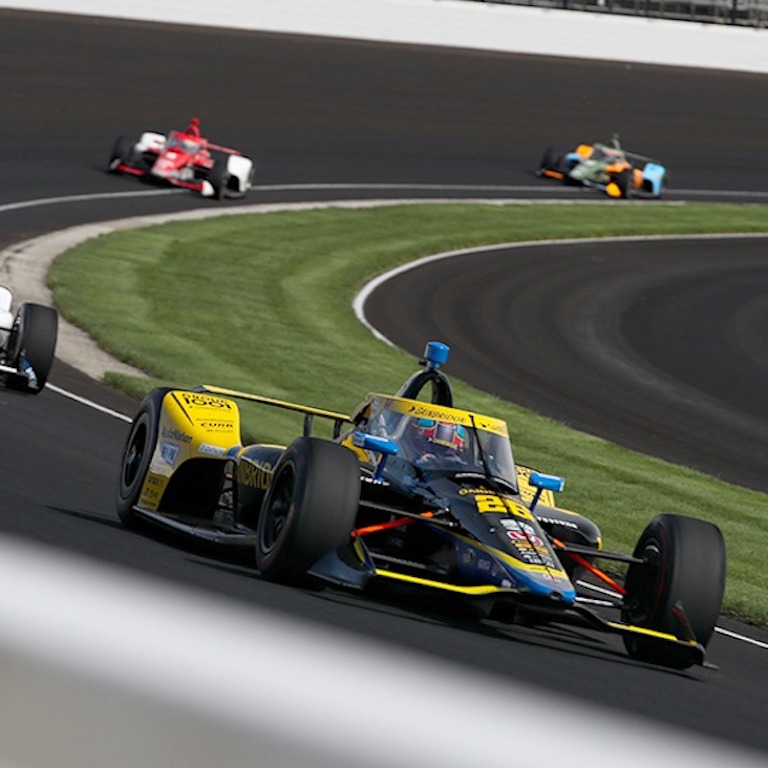
Photo courtesy of NTT IndyCar Series
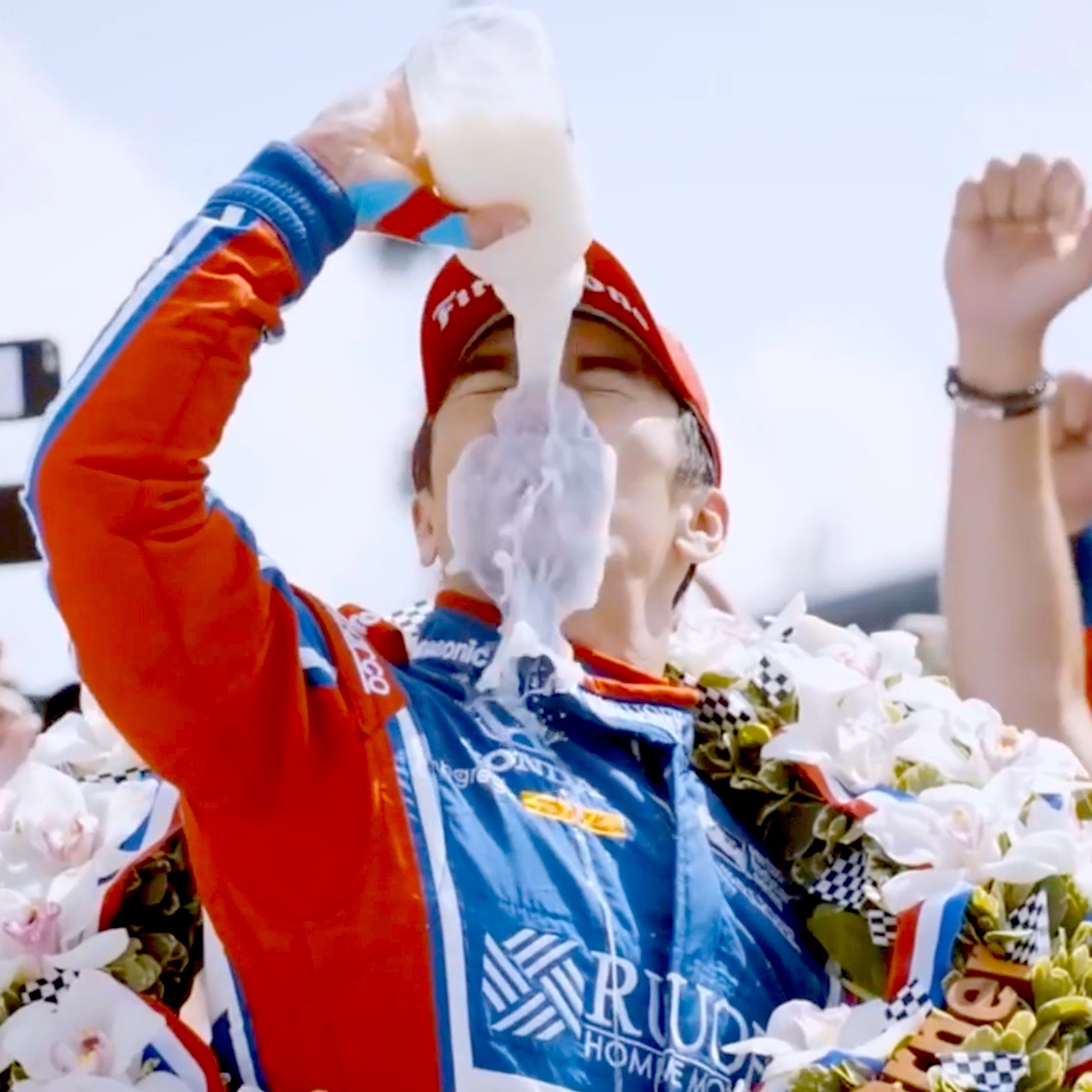
Photo courtesy of NTT IndyCar Series
The Indy Autonomous Challenge sparks a new era of innovation at IMS.
For all its history, the Indianapolis Motor Speedway is also a hub of cutting-edge innovation. From the invention of the rear-view mirror to autonomous vehicle development, this iconic race track has always been a testbed for major automotive advancements.
Their latest breakthrough in on-site auto research has been the Indy Autonomous Challenge (IAC), which is the only active motorsports series for autonomous race cars! Teams of university students from around the world compete to design, test, and run software to race fully autonomous vehicles.
The IAC uses simulated environments to challenge students’ software algorithms to adapt to a variety of different courses. The goal of this challenge is to test the stability and control of each autonomous vehicle in order to improve their safety and hasten their commercialization. And best of all, winners of the competition not only get monumental bragging rights, but also a $1 million prize!
“Indy Autonomous Challenge race cars [are] powered by normal racing engines, but the brains of it are computers. It really brings the best and brightest engineers here to Indiana. Technology is so important to our economy, and we are a leader not just in the U.S. but globally.”
IMS hosted the first Indy Autonomous Challenge back in 2021, helping to pioneer the next generation of auto racing right here in Indiana. But since then, IAC has traveled across the country, hosting competitions in different racing communities. Check out their website to learn more about The World’s Fastest Autonomous Race Car competition and find out when this action-packed contest will return to the Indianapolis Motor Speedway!
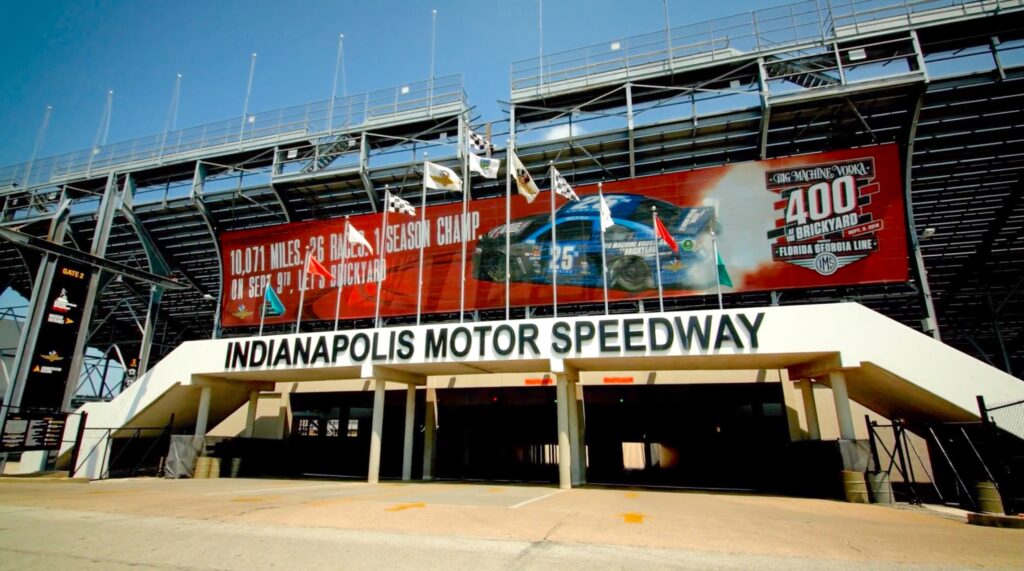
Photo courtesy of Indianapolis Motor Speedway
Experience the “Place Where America Learned to Race.”
If you’re in town to visit the Indianapolis Motor Speedway and can’t get enough of the automotive excitement, no worries! There are dozens of opportunities for you to experience The Racing Capital of the World.
Inside the track, you’ll find the historic IMS Museum with carefully preserved automobiles and exhibits recounting the speedway’s greatest moments. The museum is currently closed for reservations, but you can still tour the track with one of their expert guides! Step foot on the legendary oval track and kiss the bricks for yourself, or see the IMS through the eyes of a champion with their “View from the Top” tour!
If you’ve ever wondered what it’s like to drive an IndyCar, the Indy Racing Experience has got you covered! Founded by local automotive industry veterans, Jeff Sinden and Joe Kennedy, the Indy Racing Experience takes participants on ride-along adventures, where you can experience speeds up to 80 mph!
And after you’ve soaked up the magic of IMS, you can learn more just down the road at the Dallara IndyCar Factory! Thanks to Indy’s vibrant racing history and strong auto industry, this European manufacturer decided to set up shop less than a mile from the renowned IMS! Dallara became the official chassis supplier of IndyCar in 2012, which means they manufacture frames for all modern IndyCars. Now, you can tour their facility and see behind the scenes of how these important IndyCar parts are made!
From the top of its towering Pagoda to its century-old bricks—the Indianapolis Motor Speedway is a landmark that encapsulates the time-honored tradition of motorsport in Indianapolis. Whether you’re new to Indiana or you’ve been a Hoosier all your life, a visit to the Indianapolis Motor Speedway is a bucket-list worthy experience for all!


